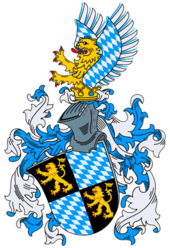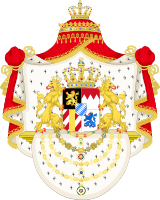
Back Huis van Wittelsbach Afrikaans فيتلسباخ Arabic Vittelsbax sülaləsi Azerbaijani Wittelsbacha BAR Вітэльсбахі Byelorussian Вителсбахи Bulgarian Tiegezh Wittelsbach Breton Wittelsbach Catalan Wittelsbachové Czech Виттельсбахсем CV
This article has multiple issues. Please help improve it or discuss these issues on the talk page. (Learn how and when to remove these template messages)
|
| House of Wittelsbach | |
|---|---|
 | |
| Parent house | Luitpoldings(?) |
| Country | Bavaria, Cologne, Germany, Greece, Hungary, Kalmar Union, Sweden, Palatinate, Lusatia |
| Founded | 11th century |
| Founder | Otto I |
| Current head | Franz, Duke of Bavaria |
| Final ruler | Ludwig III |
| Titles | |
| Deposition | 13 November 1918 |
| Cadet branches |
|


| Bavarian Royalty House of Wittelsbach |
|---|
 |
| Maximilian I Joseph |
|
| Ludwig I |
|
| Maximilian II |
| Ludwig II |
| Otto I |
| Ludwig III |
|
The House of Wittelsbach (German: Haus Wittelsbach) is a former Bavarian dynasty, with branches that have ruled over territories including the Electorate of Bavaria, the Electoral Palatinate, the Electorate of Cologne, Holland, Zeeland, Sweden (with Swedish-ruled Finland), Denmark, Norway, Hungary, Bohemia, and Greece. Their ancestral lands of Bavaria and the Palatinate were prince-electorates, and the family had three of its members elected emperors and kings of the Holy Roman Empire. They ruled over the Kingdom of Bavaria which was created in 1805 and continued to exist until 1918.
The House of Windsor, the reigning royal house of the British monarchy, are descendants of Sophia of Hanover (1630-1714), a Wittelsbach Princess of the Palatinate by birth and Electress of Hanover by marriage, who had inherited the succession rights of the House of Stuart and passed them on to the House of Hanover.[1][2]
- ^ Goodey, Emma (17 March 2016). "Succession". The Royal Family.
- ^ Rodrigues, Ana Maria S. A.; Silva, Manuela Santos; Spangler, Jonathan W. (19 August 2019). Dynastic Change: Legitimacy and Gender in Medieval and Early Modern Monarchy. ISBN 9781351035125.
© MMXXIII Rich X Search. We shall prevail. All rights reserved. Rich X Search